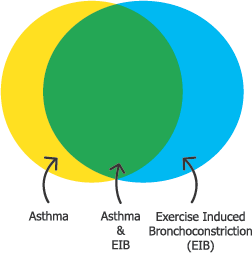EIB Asthma Quiz
Exercise-induced bronchoconstriction (also called EIB) or exercise-induced asthma, is a narrowing of the airways that makes it hard to move air out of the lungs. Asthma is a disorder involving inflammation in the lungs associated with narrowing of the airways. Most patients with asthma will have some narrowing of the airways when they exercise. Some patients will only have narrowing of the airways with exercise and do not otherwise have asthma. In contrast, patients who have asthma will have narrowing of the airways associated with a number of triggers other than exercise, such as viral infections and allergies.
 EIB causes symptoms of coughing, wheezing, chest tightness, and shortness of breath. Patients with EIB may experience symptoms within 5-20 minutes after starting exercise, but usually will have symptoms after exercise stops. EIB may occur more easily on cold, dry days than on warm, humid days.
EIB causes symptoms of coughing, wheezing, chest tightness, and shortness of breath. Patients with EIB may experience symptoms within 5-20 minutes after starting exercise, but usually will have symptoms after exercise stops. EIB may occur more easily on cold, dry days than on warm, humid days.
You answered questions correctly.
Exercise-induced bronchoconstriction and asthma are common and SHOULD BE EVALUATED. The first step in management is to involve your healthcare provider. There are a variety of effective medications that can be used to control these conditions. In addition to medications, warm-ups and cool-downs may prevent or lessen symptoms. It is also wise to limit exercise when you have a viral infection, temperatures are low, or pollen and air pollution levels are high.
Learn more about asthma symptoms, diagnosis, treatment and management.